Abstract
This study investigates the impact of three key factors - irrigation deficit percentage, NPK application rate, and tillage - on soil moisture content, a crucial parameter in agricultural productivity. To achieve this, a field experiment was conducted at Nnamdi Azikiwe University's Department of Agricultural and Bioresources Engineering Experimental Site/Farm Workshop, Awka. The experiment utilized a central composite design in response surface methodology, incorporating three factors: irrigation deficit percentage, NPK application rate, and tillage. This design enabled the researchers to examine the individual and interactive effects of these factors on soil moisture content. The results of the study revealed that the model was highly significant, with an R-squared value of 0.9084. This indicates that approximately 91% of the variation in soil moisture content could be explained by the model. Furthermore, the analysis showed that irrigation deficit percentage, NPK application rate, and tillage were all significant factors influencing soil moisture content. However, the interaction terms between these factors were found to be non-significant. A key outcome of this study was the development of predictive models for soil moisture content under different tillage conditions, namely No Tillage, Conservative Tillage, and Conventional Tillage. These models could be employed to forecast soil moisture content for specified levels of irrigation deficit percentage and NPK application rate under each tillage condition. The findings of this research provide valuable insights into the effects of irrigation deficit percentage, NPK application rate, and tillage on soil moisture content. These insights could be applied to inform agricultural practices in similar regions, ultimately contributing to improved crop yields and sustainable agricultural management.

This work is licensed under a Creative Commons Attribution-NonCommercial-NoDerivatives 4.0 International License.
Copyright (c) 2025 ARID ZONE JOURNAL OF ENGINEERING, TECHNOLOGY AND ENVIRONMENT

